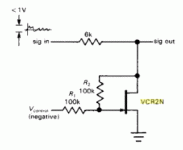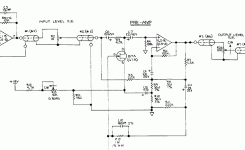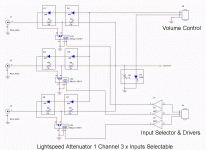ROHS compliance
George,
It seems that just about every second industry that uses hazardous materials, applies for and receives a dispensation from the "powers that be" to continue on their merry way although most have simply shifted their factories out to Asia where waste disposal of REALLY "bad news" material is a bad joke and an environmentalist's nightmare.
Sad to see you're having trouble with the Tent clocks and the other things - it's not easy anymore from Europe.
George,
It seems that just about every second industry that uses hazardous materials, applies for and receives a dispensation from the "powers that be" to continue on their merry way although most have simply shifted their factories out to Asia where waste disposal of REALLY "bad news" material is a bad joke and an environmentalist's nightmare.
Sad to see you're having trouble with the Tent clocks and the other things - it's not easy anymore from Europe.
Heat the speed?
A very interesting thread this is indeed.
I think the idea is a stroke of genius.
It got me thinking a bit further. What if we replace the LDR with a resistor which varies on temperature. These tend to behave very linear, so matching would be much easier.
We then have to make a variable heater which responds quickly enough to be a useful volume control (we don't want the music go load only 5 minutes after turning the knob). maybe some resistive wire (constantan wire) could do the tric. Glue that on a resistor (make it two, one for each channel) with heat conducting glue. Use a pot to make the current trough the wire variable etc. etc.
As there is nothing like a free lunch, What will be the catch?
MArco
A very interesting thread this is indeed.
I think the idea is a stroke of genius.
It got me thinking a bit further. What if we replace the LDR with a resistor which varies on temperature. These tend to behave very linear, so matching would be much easier.
We then have to make a variable heater which responds quickly enough to be a useful volume control (we don't want the music go load only 5 minutes after turning the knob). maybe some resistive wire (constantan wire) could do the tric. Glue that on a resistor (make it two, one for each channel) with heat conducting glue. Use a pot to make the current trough the wire variable etc. etc.
As there is nothing like a free lunch, What will be the catch?
MArco
Re: Heat the speed?
The ambient temperature where you live is between 15-30 Celsius.
Where I live it's between 30-40.
deduikertjes said:
As there is nothing like a free lunch, What will be the catch?
The ambient temperature where you live is between 15-30 Celsius.
Where I live it's between 30-40.

Re: Heat the speed?
I've made such a thing in the past, and it does work, but not that well.
There are several catches. The part you are talking about is a
thermistor, and it will have some distortion of its own. The
tracking is not much better, and for a reasonable heater system,
the range is not very good and the response time is quite slow.
deduikertjes said:It got me thinking a bit further. What if we replace the LDR with a resistor which varies on temperature. These tend to behave very linear, so matching would be much easier.
We then have to make a variable heater which responds quickly enough to be a useful volume control (we don't want the music go load only 5 minutes after turning the knob). maybe some resistive wire (constantan wire) could do the tric. Glue that on a resistor (make it two, one for each channel) with heat conducting glue. Use a pot to make the current trough the wire variable etc. etc.
As there is nothing like a free lunch, What will be the catch?
I've made such a thing in the past, and it does work, but not that well.
There are several catches. The part you are talking about is a
thermistor, and it will have some distortion of its own. The
tracking is not much better, and for a reasonable heater system,
the range is not very good and the response time is quite slow.
If one uses a tungsten filament lamp for the sensor, much of the linearity isues should be solved. Maybe, while restricting us to AC signals and arbitrarily slow response time (no thumping) one could just use a DC bias current for direct heating instead of indirect heating (via external IR source or RF induction heating, etc). Problem, as usual, is the L/R-tracking, but this can be made somewhat less important with temporal rematrixing L/R into M/S (which has its own issues if to be executed as a true high-end signal chain). Also a single filament only has a 1:10 resistance change, at most. A cascaded divider would be surely needed,and many more issues make the approach look very unappealing
- Klaus
- Klaus
The Lightspeed is propably the best sounding volume control I've heard so far. The frustrating part is the use of CdS which is forbidden by RoHS directive in Europe. So, one can build it in his home for his own pleasure (with lead solder  ) and have fun. But you can't sell it or make a business.
) and have fun. But you can't sell it or make a business.
And perhaps if one optocoupler goes west there are perhaps no spare parts available in Europe and you have to deal with Silonex like pot or so. Why don't thinking about similiar genius other solutions?
Has someone experience with the Vishay JFET Voltage-Controlled Resistors VCR2N e.g.?
Innovate don't imitate 😀
 ) and have fun. But you can't sell it or make a business.
) and have fun. But you can't sell it or make a business. And perhaps if one optocoupler goes west there are perhaps no spare parts available in Europe and you have to deal with Silonex like pot or so. Why don't thinking about similiar genius other solutions?
Has someone experience with the Vishay JFET Voltage-Controlled Resistors VCR2N e.g.?
Innovate don't imitate 😀
A known topology. Attached find a more refined circuit (linearized). Essentially the heart (voltage controlled gain cell) of the famous UREI 1176/1178 Peak Limiter. If you don't like opamps, replace it with a discrete stage (earlier models had discrete stages throughout) 😉
- Klaus
- Klaus
Attachments
I think one goal is so few parts in the signal way as possible! The passive character should be restrained or "keep it simple"!
Hal where's our buffer?
All the new names, don't foget to vote for the Passive Preamp forum, http://www.diyaudio.com/request/
Cheers George
All the new names, don't foget to vote for the Passive Preamp forum, http://www.diyaudio.com/request/
Cheers George
Input impedence
George,
After I finished reading the whole thread and know that you suggested to people that we might change the input resistor to couple with lightspeed, but don't turn-on without the attach of the lightspeed. Can you spend a little of your time to check with my case.
Please check the following link for DX HR 11
http://www.dxamp.com/construction/HRII/
Thanks
Albert
George,
After I finished reading the whole thread and know that you suggested to people that we might change the input resistor to couple with lightspeed, but don't turn-on without the attach of the lightspeed. Can you spend a little of your time to check with my case.
Please check the following link for DX HR 11
http://www.dxamp.com/construction/HRII/
Thanks
Albert
georgehifi said:Hal where's our buffer?
I have numerous versions. If I let you have one now, will you
wait patiently for the others?
Nelson Pass said:
I have numerous versions. If I let you have one now, will you
wait patiently for the others?
Yes Hal 😉

Re: Input impedence
Albert hi, if you wait a little, Hal, I mean Nelson will have his new Fet buffer posted soon, in the meantime he will post one of his earlier ones I think.
Looking at your amp circuit, it is only 12k, governed by R17, I think if you change this to say 100k, and then the Lightspeed will will then replace the 12k by it's own 7k output impedance, then your input filter C16 with the 7k of the Lightspeed will still be around -3db @100khz, still fast enough bandwidth, but never power up your amp without the Lightspeed conected. Also check this with the designer of your amp.
Or just wait for Hal's (Nelson's) super fet buffer.
Cheers George
albertli said:George,
After I finished reading the whole thread and know that you suggested to people that we might change the input resistor to couple with lightspeed, but don't turn-on without the attach of the lightspeed. Can you spend a little of your time to check with my case.
Please check the following link for DX HR 11
http://www.dxamp.com/construction/HRII/
Thanks
Albert
Albert hi, if you wait a little, Hal, I mean Nelson will have his new Fet buffer posted soon, in the meantime he will post one of his earlier ones I think.
Looking at your amp circuit, it is only 12k, governed by R17, I think if you change this to say 100k, and then the Lightspeed will will then replace the 12k by it's own 7k output impedance, then your input filter C16 with the 7k of the Lightspeed will still be around -3db @100khz, still fast enough bandwidth, but never power up your amp without the Lightspeed conected. Also check this with the designer of your amp.
Or just wait for Hal's (Nelson's) super fet buffer.
Cheers George
If Nelson is going to release his design very soon. I certainly would love to wait a bit/ or even longer for the better one.
Albert🙂
Albert🙂
I am about to start building 3 mono LS MK2 clones.
The setup will be 2 Class D mono blocks for the side speakers + an active sub. The mono blocks work balanced and the sub is single.
The idea is to build a central control unit that contains:
-4 deck pot (3tracks to be used)
-2 small pots for L-R Balance.
-power supply for 3 x LS
-1 LS that drives the sub.
(+ 2 DACs and a set of filters + buffer for the sub)
The other 2 LS units sit in the Class D mono blocks housing, and will be connected to the volume POT pins.
I have 3 questions here.
1. I need to run a 4 meter (12 feet) 2 lead control cable from the control unit to the LS in the mono blocks. I haven't got a clue if this will influence my sound (I guess not).
2. Will the LS be able to work properly in this position (impedance??)
3. I am not yet clear on what kind of input selector (3x) to use
What do you think, will this work and ...... give the best sound.
Cheers
Peter
(this is the Class D unit)
The setup will be 2 Class D mono blocks for the side speakers + an active sub. The mono blocks work balanced and the sub is single.
The idea is to build a central control unit that contains:
-4 deck pot (3tracks to be used)
-2 small pots for L-R Balance.
-power supply for 3 x LS
-1 LS that drives the sub.
(+ 2 DACs and a set of filters + buffer for the sub)
The other 2 LS units sit in the Class D mono blocks housing, and will be connected to the volume POT pins.
I have 3 questions here.
1. I need to run a 4 meter (12 feet) 2 lead control cable from the control unit to the LS in the mono blocks. I haven't got a clue if this will influence my sound (I guess not).
2. Will the LS be able to work properly in this position (impedance??)
3. I am not yet clear on what kind of input selector (3x) to use
What do you think, will this work and ...... give the best sound.
Cheers
Peter
(this is the Class D unit)
And once more
http://www.class-d.net/MCD-255 datasheet(test%20version%201.1).pdf
Sorry for this mess: you have to copy the text in to the browser since the hyperlink does not work
http://www.class-d.net/MCD-255 datasheet(test%20version%201.1).pdf
Sorry for this mess: you have to copy the text in to the browser since the hyperlink does not work
peterhenk said:I have 3 questions here.
1. I need to run a 4 meter (12 feet) 2 lead control cable from the control unit to the LS in the mono blocks. I haven't got a clue if this will influence my sound (I guess not).
2. Will the LS be able to work properly in this position (impedance??)
3. I am not yet clear on what kind of input selector (3x) to use
What do you think, will this work and ...... give the best sound.
Cheers
Peter
(this is the Class D unit)
Hi, Peter, my thoughts.
1: Depends on how strong I/ low z your source is
2: The amp seems to have a buffer option on the input wich is the best but still too low at 18k but this could be just a resistor change
3: If you really want to go all out do the one attached.
Now for my coments on the Class D:
I have never seen 10k or 20k square waves produced this clean without noise obliterating the tops of the square waves from any Class D amp regarless of price, which makes me believe these shots are doctored up to the max.
Cheers George
Attachments
- Home
- Source & Line
- Analog Line Level
- Lightspeed Attenuator a new passive preamp


